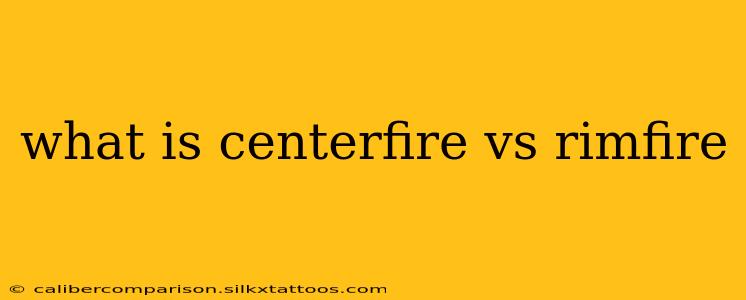Choosing the right ammunition for your firearm is crucial, and understanding the fundamental differences between centerfire and rimfire cartridges is the first step. This guide delves into the core distinctions, advantages, and disadvantages of each, helping you make informed decisions based on your shooting needs.
What is Centerfire Ammunition?
Centerfire ammunition derives its name from the location of the primer—it's situated in the center of the cartridge base. This small, explosive charge ignites the gunpowder when struck by the firing pin. The design allows for significantly higher pressures and velocities compared to rimfire.
Advantages of Centerfire:
- Higher Power and Velocity: Centerfire cartridges consistently deliver greater power and velocity, making them ideal for hunting, long-range shooting, and self-defense.
- Reusability of Cases: The robust construction allows for reloading, a cost-effective practice for frequent shooters. This significantly reduces the overall cost of ammunition over time.
- Wider Range of Calibers and Applications: Centerfire encompasses a vast array of calibers and designs, catering to various firearms and purposes.
- Improved Accuracy Potential: The more robust design contributes to improved accuracy and consistency.
Disadvantages of Centerfire:
- Higher Cost: Generally, centerfire ammunition is more expensive than rimfire.
- More Complex Reloading Process: While reloading is cost-effective, it requires more specialized equipment and knowledge.
- Typically Larger and Heavier: Centerfire cartridges are usually larger and heavier than rimfire cartridges.
What is Rimfire Ammunition?
In rimfire ammunition, the primer is located within the rim of the cartridge case. The firing pin strikes the rim, causing the primer to ignite. This simpler design results in lower pressures and velocities.
Advantages of Rimfire:
- Lower Cost: Rimfire ammunition is significantly cheaper than centerfire.
- Simpler Design and Manufacturing: The simpler design results in lower manufacturing costs, contributing to the lower price point.
- Smaller and Lighter: Rimfire cartridges are generally smaller and lighter, making them suitable for smaller firearms and easier to carry.
Disadvantages of Rimfire:
- Lower Power and Velocity: Rimfire cartridges generate considerably less power and velocity compared to centerfire, limiting their effective range and suitability for certain applications.
- Non-Reusable Cases: The weaker construction of the case prevents reloading, making it a less cost-effective option in the long run.
- Increased Sensitivity to Misfires: Rimfire cartridges can be more prone to misfires and variations in ignition.
- Limited Calibers and Applications: The number of available calibers and applications is more limited than with centerfire ammunition.
Centerfire vs. Rimfire: A Side-by-Side Comparison
| Feature | Centerfire | Rimfire |
|---|---|---|
| Primer Location | Center of the cartridge base | Inside the rim of the cartridge case |
| Power & Velocity | High | Low |
| Cost | Higher | Lower |
| Reloading | Possible | Not possible |
| Accuracy | Generally higher | Generally lower |
| Applications | Hunting, target shooting, self-defense | Small game hunting, target practice, plinking |
| Case Durability | High | Low |
Conclusion
The choice between centerfire and rimfire ammunition hinges on your specific needs and intended use. Rimfire cartridges offer affordability and simplicity for casual shooting and small-game hunting. Centerfire ammunition, on the other hand, provides the power and versatility necessary for hunting larger game, self-defense, and more demanding shooting disciplines. Understanding these fundamental differences will significantly aid your decision-making process in selecting the right ammunition for your firearm and purpose.

